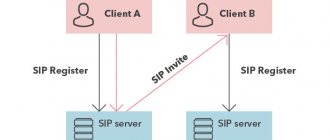Recommendations In our articles, we have already talked about special IP phones and softphones for calls over the Internet. Today you will learn how to connect your company’s existing analog phones to IP networks using a VoIP gateway.
- How does a VoIP gateway work?
- Why do companies use VoIP gateways?
- How to choose a VoIP gateway?
Often, a VoIP gateway is also called a SIP gateway or voice gateway, since it is the one that encodes and decodes voice when transmitted through the SIP protocol.
What is a VoIP gateway
A VoIP gateway is a device that allows you to connect analog telephones to IP networks to work in IP telephony networks. Also, these gateways can work with classic telephone lines, converting the signal to digital and providing distribution of calls to IP phones via IP PBX. In appearance, they resemble routers equipped with ports for connecting telephone lines, handsets, local networks and the Internet. Individual gateways are designed for installation in a server rack - they provide work with a large number of subscribers and lines, with high performance and fault tolerance.
Varieties
VoIP gateways come in the following varieties:
- Simple single-channel devices that allow you to connect only one telephone set - in fact, these are simple VoIP adapters, suitable not only for office, but also for home use.
- Multichannel devices - work with a large number of subscribers, redirecting calls to several handsets. They can also work with a large number of telephone lines connected to the corresponding ports.
There is also a classification by ports, which will be discussed a little later.
Operating principle
The subscriber's IP telephony gateway is connected to the PBX with forwarding configured. After installing the equipment, all international and long-distance calls will begin to arrive at the VoIP gateway. Despite the technological nuances, the scheme looks quite simple: a call goes from an office worker’s phone through a PBX to a VoIP gateway, then through the Internet network to an IP telephony operator, and then directly to a remote subscriber.
Such a system is fully justified by more favorable tariffs, so the company’s costs for telephone communications will be reduced by an order of magnitude compared to using the services of conventional wire line operators.
The device and how the voice gateway works
The simplest voice gateway is a small device equipped with three connectors - for connecting to the Internet (or local network), for connecting a telephone, and for connecting power. It works extremely simply - it converts the analog signal from the handset into a digital one, and then sends it through the network to an IP-PBX or to an IP provider. Likewise, it takes a digital stream and converts it to analog. In other words, the gateway ensures the transmission of voice traffic in both directions while simultaneously converting the signals into digital or analog form.
Devices with FXO ports work slightly differently, although the principle is almost the same. They are equipped with one or more ports designed to connect telephone lines. They are also connected via LAN ports to office IP PBXs. The equipment provides reception and distribution of calls coming from the city telephone network, and allows you to make voice calls from internal handsets through the PSTN.
PSTN (aka PSTN) stands for public telephone network, operating within city PBXs.
Classification of VoIP gateways by ports
Gateways can be not only single-channel and multi-channel. They are divided into devices with FXO and FXS ports. FXO is an analog subscriber interface that awaits connection from the station or gateway. Telephone lines are connected to these ports. FXS is a port to which subscriber devices are connected, which include faxes, modems and regular telephones. In other words, FXS provides the service, and FXO waits for it to connect.
Gateways with FXO ports are connected to city telephone lines and to IP-PBX, providing switching of calls from the PSTN to internal telephones of the IP network. Gateways with FXS ports act as adapters - they connect to IP networks, providing digital-to-analog conversion. Telephone sets are connected to the FXS ports in these gateways.
Market situation
In the Russian market of VoIP gateways for small and medium-sized businesses, the leading player today is AddPac Technology . The Korean manufacturer not only has the widest range of equipment, but also combines this advantage with reliability and often a lower price than its competitors. AddPac has more than 20 models in its arsenal: from today’s popular one/dual/four-channel VoIP gateways for small companies, to multi-port (32 or more voice channels) devices that are becoming increasingly in demand by medium-sized businesses.
What to choose: PBX expansion card or VoIP gateway
The expansion card allows you to connect additional internal subscribers. This is necessary when increasing the number of jobs at the enterprise. But the cost of PBX expansion cards is quite high, while purchasing VoIP gateways is much cheaper. At the same time, they are easier to maintain and configure, which allows you to get rid of additional costs for the services of adjusters - your own IT specialists can handle the task.
Voice gateways are also characterized by better compatibility with equipment from other brands, which makes IP telephony more reliable and stable.
Optimizing the signal transmission process
When transmitting a signal, a certain interval is formed between the utterance of speech on one side and its reproduction on the other. This interval is on average no more than 45 milliseconds. The reason for its occurrence is the peculiarity of the functioning of the signal accumulation buffer and delays of an algorithmic and computational nature. Occasionally, distortions of synthesized speech are added here, which can be caused by the loss of some codecs and exceeding the signal transmission time.
But this is not a critical problem today. Speech can be compressed using various algorithms to make the signal exchange process better and reduce delays to a minimum. There are other ways to improve the quality of communication - for example, an IP telephony gateway can block the transmission of pauses in the dialogue, which will save network time. Such natural pauses can take up to half of the network time.
There are certain quantitative indicators that providers use to determine the quality of data transmission in order to properly optimize communications. We are talking about the MOS Score parameter (scale from 1 to 5). Using these data, the provider assesses the dynamics of quality improvement/deterioration. There are also ASR/ABR/ACD parameters that measure relative load, average line usage time, etc.
Overview of popular SIP gateway options
We figured out what gateways are and how they work. Now we will look at several of the most popular models from the most famous manufacturers. They have found their application at home and in offices.
CISCO SPA112-XU
A simple and reliable telephone gateway from the world famous Cisco brand, providing access to IP networks. It is equipped with two FXS ports to which handsets are connected. An RJ-45 port is used to connect to a local network or the Internet.
Features and capabilities of the gateway:
- Support for SIP protocol (including the second version).
- Musical accompaniment in standby mode.
- Supports three-way conference calls.
- Classic telephone functions - waiting, forwarding and interception.
- Caller ID and caller ID barring function.
- Fax support.
The device is easy to set up and provides high-quality voice transmission. Users note its stable operation, and its affordable price (about 2500-3200 rubles) makes it possible to use it not only for office purposes, but also at home.
Grandstream GXW-4108 (FXO)
This is a classic gateway with FXO ports for connecting telephone lines. Its features:
- Possibility of setting in automatic mode.
- High fault tolerance, ensuring stable operation of office telephony.
- Possibility of integration with IP-PBX from any manufacturer.
- Simultaneous operation of eight telephone lines connected to the FXO ports on the rear panel.
- SIP protocol support.
- H.264 video codec support for video calls over IP networks.
- Powerful functionality, successfully combined with ease of setup.
This gateway is designed to work in enterprises with a large number of jobs. There are no FXS ports, but there is support for call forwarding and Caller ID. Two LAN ports are provided for connecting to IP networks and PBX. The device also supports router functions. The cost of the device varies between 19-23 thousand rubles.
The basic package includes a payment card for the IP provider Sipnet, but nothing prevents you from using the gateway to connect to any other providers - for example, Zadarma.
D-Link DVG-7111S
Another simple voice VoIP gateway for home and office use. Its key feature is the ability to work with IP networks and traditional telephone lines, for which there are LAN, WAN, FXS and FXO ports on board. The device is equipped with an expanded LED indication that allows you to monitor the status of the ports and the status of the gateway.
Features and capabilities of the device:
- Generation of comfortable noise – adds “white noise” to the conversation, filling pauses in conversations (otherwise it creates the impression of a disconnection).
- Voice activity control – allows you to save traffic.
- Echo cancellation function for better voice transmission.
- Supports classic telephone functions - forwarding, redialing, conferencing, call transfer, wait/hold and many others.
- Pulse dialing support for working with analog PBXs.
- Phone book support.
- Built-in routers.
The gateway features stable operation and can be used in small offices or at home. Thanks to the presence of the FXO port, it is possible to create dialing rules when PSTN is used for local communications, and IP telephony resources are used for long-distance communications. The estimated cost of this model is from 3,700 to 5,000 rubles, depending on the appetites of a particular outlet.
D-Link DVG-N5402GF/A1A
Here is a router with VoIP gateway functions. It is equipped with a Wi-Fi module, providing clients with an Internet connection. It also has two FXS ports for connecting telephones, a combined WAN port with the ability to connect an optical cable, and four LAN ports for connecting computers and other equipment. The D-Link DVG-N5402GF/A1A gateway is aimed at office use, but is also suitable for home use. Thanks to two antennas at once, it creates a wide Wi-Fi coverage area necessary for connecting smartphones, tablets and other devices to the Internet. The estimated cost of the gateway is 9,000 rubles.
In fact, there are many more popular VoIP gateways. For home use, it is recommended to choose the simplest equipment - consumers often do not use additional functionality. As for office use, preference should be given to expensive equipment from well-known brands, which is highly fault-tolerant and capable of operating under high loads.
0 0 Votes
Article rating
Advantages over other IP telephony equipment
VoIP telephony is in demand among operators providing information services over the phone. Contact centers, network companies, national corporations and other subscriber groups prefer to use this voice technology due to its advantages:
- independence from geolocation, allowing the call center operator to work both at his workplace and in a remote office with a stable connection;
- connection security;
- possibility of connecting video communication;
- call routing;
- phone number transfer;
- the ability to integrate with CRM to increase the efficiency of internal communications in the company.
The advantage of VoIP telephony is cheap communication, including free long-distance and international calls. To access a dedicated communication channel, a subscriber can use a computer, an IP phone, or even a regular landline phone. The use of voice services allows companies to build an effective internal communication channel between employees and entire departments. The implementation of such gateways is much faster, and they can be connected to any brand of PBX.











